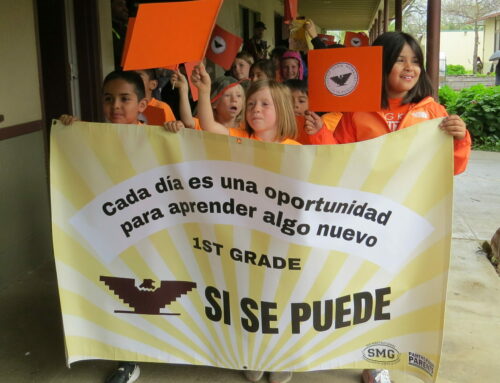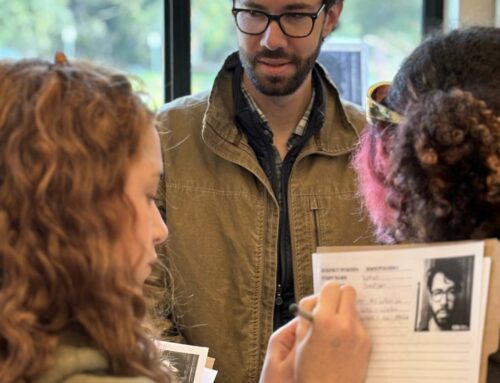Students should return to newly wired, painted schools with new desks
Published in the August 6 – 19, 2014 issue of Morgan Hill Life
By Marty Cheek

Photo by Marty Cheek
Two workers tend to the roof of a building at P.A. Walsh Elementary School as part of Measure G, which provides funds for various projects throughout the district.
When students in the Morgan Hill Unified School District step back into classrooms next week, many will see significant facility and technology improvements done during the summer. These benefits come thanks to the first phase of Measure G, the $198 million bond measure passed with a 66 percent approval by school district voters two years ago.
P.A. Walsh Principal Teresa Sermersheim has watched with anticipation the work being done during the past few months to the school and believes that teachers, staff, parents and students will be pleasantly surprised by the improvement in the quality of the classrooms and “innovation rooms” on campus. The upgrade in facilities and technology at P.A. Walsh will encourage students to take pride in their school, hopefully translating into higher academic performance, she said.
“They’ll stand a little taller and be ready to work and really rise to the occasion because we’re expecting a lot from our kids,” Sermersheim said. “We need to have up-to-date conditions to do what we need to do. We’ve had desks that are falling apart and chairs that are missing all the little things on the bottom so that they wobble. You wouldn’t expect that in any business that you go to.”

Photo by Marty Cheek
P.A. Walsh STEAM Academy Principal Teresa Sermersheim chronicles the process of the Measure G renovations at the school.
When P.A. Walsh learners step into classrooms spruced up with fresh paint and new carpets, they’ll sit down in new desks that are more comfortable than the old desks they knew last year. The classroom desks are not the traditional pop-up kinds that spill objects when the top is lifted up but of a more practical trapezoid shape on rollers so that they can be combined to make a table for group learning. The children will use academic software installed on Chromebook laptops in their learning of Common Core curriculum as P.A. Walsh transforms into the STEAM (science, technology, engineering, arts, and math) academy this school year. Many of the students at the school live in low-income households where parents financially can’t provide computer and other high-tech equipment at home, so the school equipment will help them compete with more affluent students in their learning progress.
“I think we’re leveling the playing field,” Sermersheim said. “We have to make sure our kids are ready for the 21st century. We got an all new infrastructure for being able to have really good Wi-Fi access, which is where we need to be with our kids. Gone are the days when we had to get the letter G book in the encyclopedia set to look something up. That’s just not what we do. So we’ve had the teachers go through professional development in the summer to help us with Chromebook and software that’s out there.”
Besides P.A. Walsh, four other district schools — El Toro and San Martin/Gwinn elementary schools and Live Oak and Sobrato high schools — received Measure G technology upgrades during the summer that includes new wireless access points, technology infrastructure, phone systems, digital clocks, bells and public address speakers. Several schools received new roofs as well as more energy efficient heating/air-condition units. Los Paseos, Barrett, Nordstrom, Paradise Valley, and Jackson Academy elementary schools had preliminary technology prep work done during the summer.

Photo by Marty Cheek
A construction employee works on the P.A. Walsh roof.
“We jumped ahead on some of the technology,” said Anessa Espinosa, director of facilities. “We wanted to make sure that installing the technology is not going to interfere with the daily activities of the schools, so we went ahead and did all of the underground trenching and all of the underground conduit placement for the remainder of the schools. Although they don’t have the actual devices in the classroom, when school starts we’ll start bidding those out and later getting the wires in.”
Starting this fall as the district’s new environmental science academy, San Martin/Gwinn is adding a new administration building, and new pathways students can follow to outdoor labs to learn about native plants and natural energy sources such as solar power cells on the ground.
Central High School — the former Burnett School site on Tilton Avenue — opened last August as the first in the wave of Measure G projects. Additional modernization work was done this summer at the campus to upgrade a multi-purpose room and an administration area so that the campus can eventually house several education programs besides Central, such as possibly a parents program and a digital high school.
Preliminary work was done the past several months at Charter School of Morgan Hill for the construction of a multi-purpose room. Workers prepared the underground utilities portion of this project, which is expected to receive final approval by the end of the year.
“We wanted to get any kind of work done that would disrupt the parking and pick up ahead of time,” Espinosa said. “It’s just underground utilities to a certain point, and then we’ll have to do the actual building pad and start construction.”
Money to pay for the first phase of facility and technology upgrades came from the $55 million raised from sales in February 2013 of the series A bonds of Measure G. The next sale is tentatively planned for 2015, based on local property value increasing, but the series B sales might be pushed to 2016 depending on planning stages of various upcoming enhancement projects, said Kirsten Perez, assistant superintendent of business services.
One big Measure G project planned for the future is building a library and classroom structure for Britton Middle School, possibly at the corner of Monterey Road and Keystone Avenue. The two-story building will have an entrance on Monterey that will allow public use during off-school hours. The school board recently approved spending $750,000 for preliminary planning and drawings. The district will also look into getting funding from the state to supplement Measure G funds.
District Superintendent Steve Betando sees Measure G funds not only improving the physical facilities and technology to enhance student learning and make schools safer environments, but adding value to the community overall with increased quality of life and property values rising.
“The attraction of the school really adds to the attractions of the community,” he said. “Obviously, for the city government and businesses, the schools are of value. It’s not just for education. One of the key pieces of a decision for a family moving into the community is how good the schools are.”
As Measure G improvements continue over the next several years, the Morgan Hill community will take increasing pride in its public schools as they become more aesthetically attractive, safer, and fit in better with rest of the city, he said. Measure G funds are being spent in prudent ways to allow the schools to adapt to changing technology over the years as well as cut on the district’s energy costs, he said.
“This is for the long-term,” Betando said. “We’re not just putting in a new facelift on the buildings, we’re putting in conduit so that we can put in the necessary wiring. We’re put in new air-conditioning units that are more energy efficient and will save money. Everything that we talk about is how we make it greener, how we make it more efficient.”
With the opening of the school year, Perez said she can’t wait to see students enter their classrooms for the first time since they were enhanced with the Measure G improvements this summer.
“It’ll be exciting to see how the kids react to it,” she said. “I remember being at Central (last year) when the students came back and seeing how excited they were and how nice the campus looked. They really respect the campus because they know that the community has invested in it, and that they really respect education and how much the community values education.”






